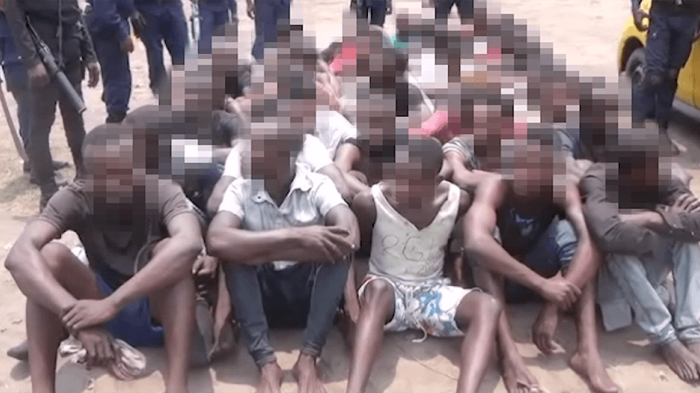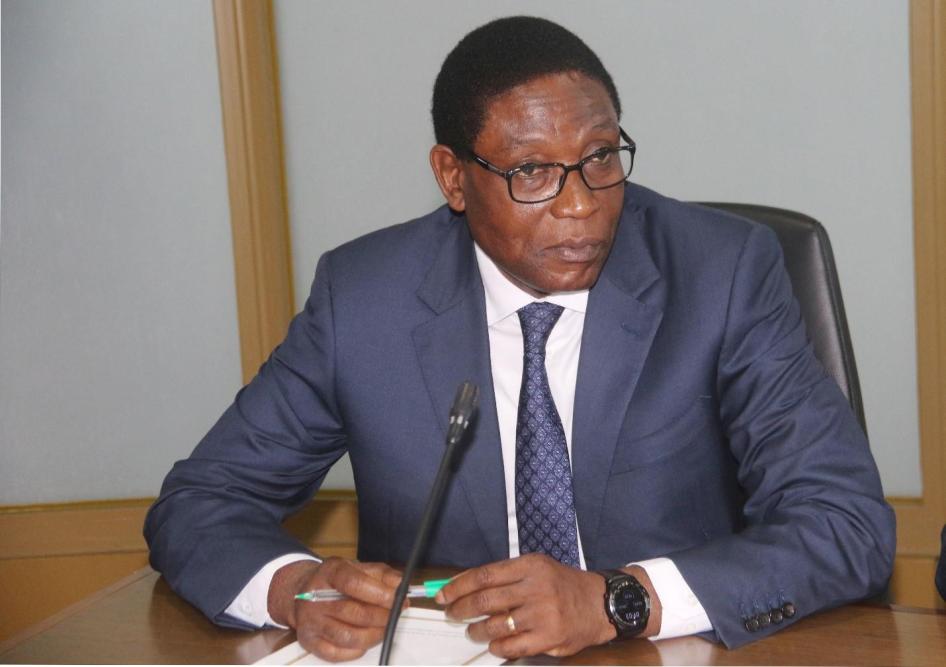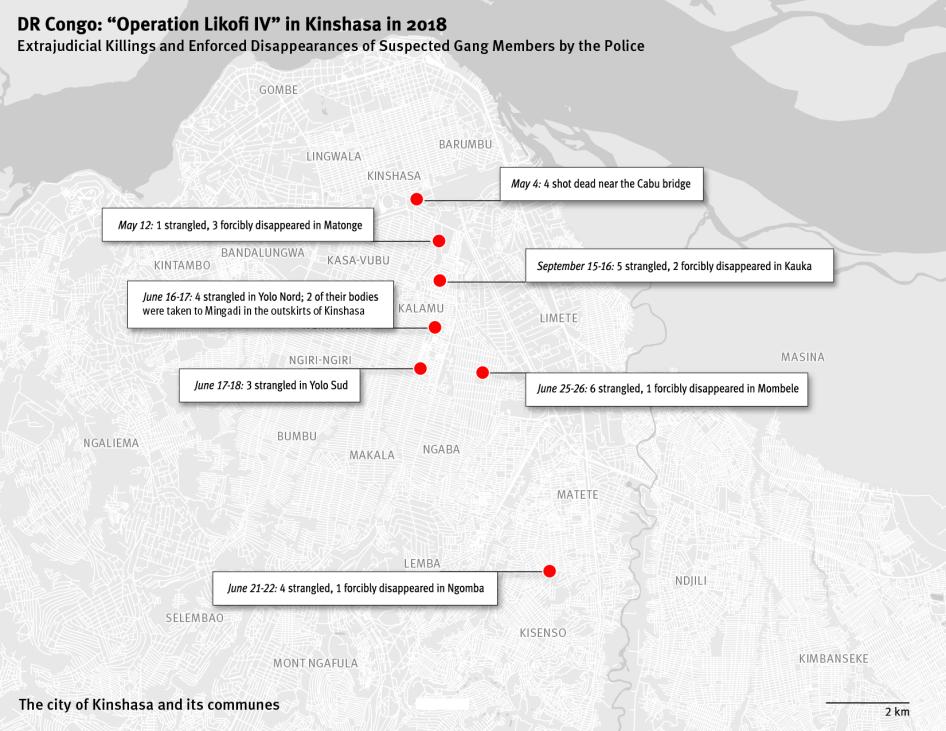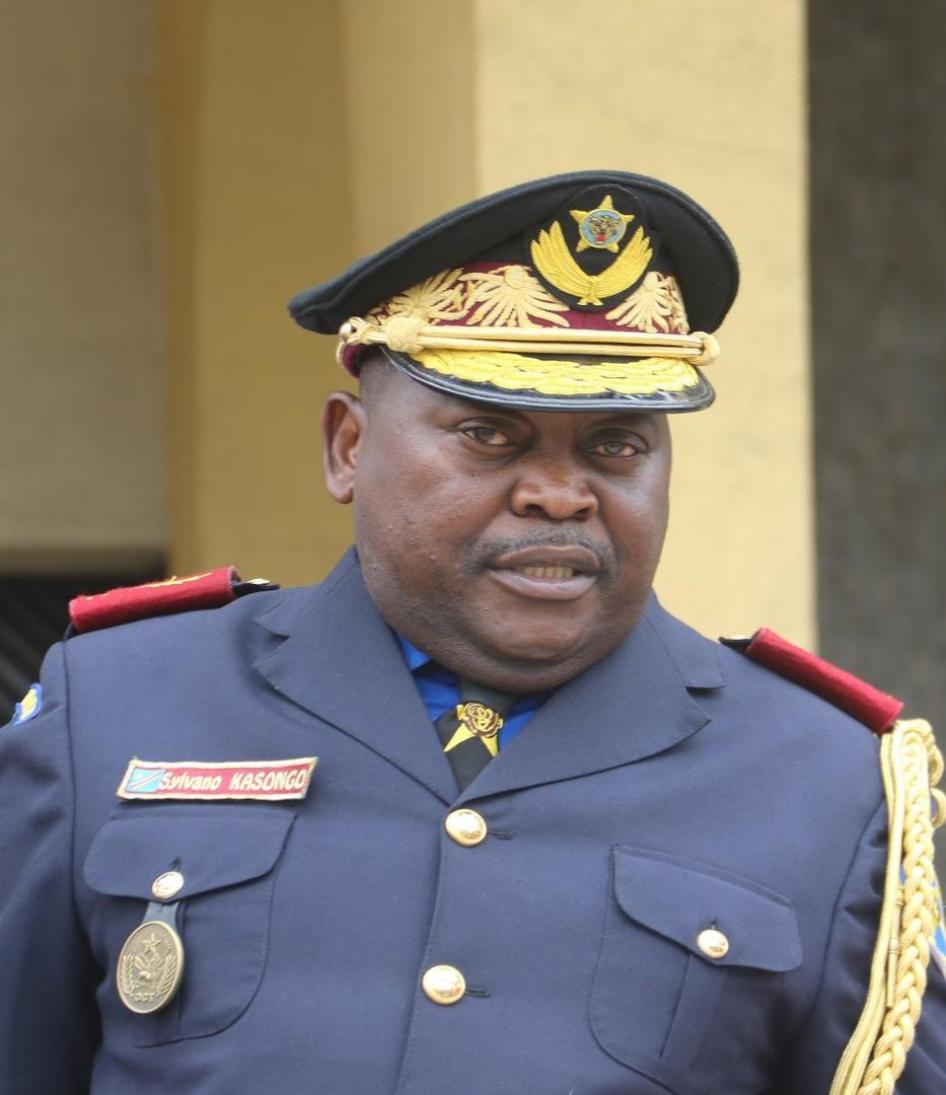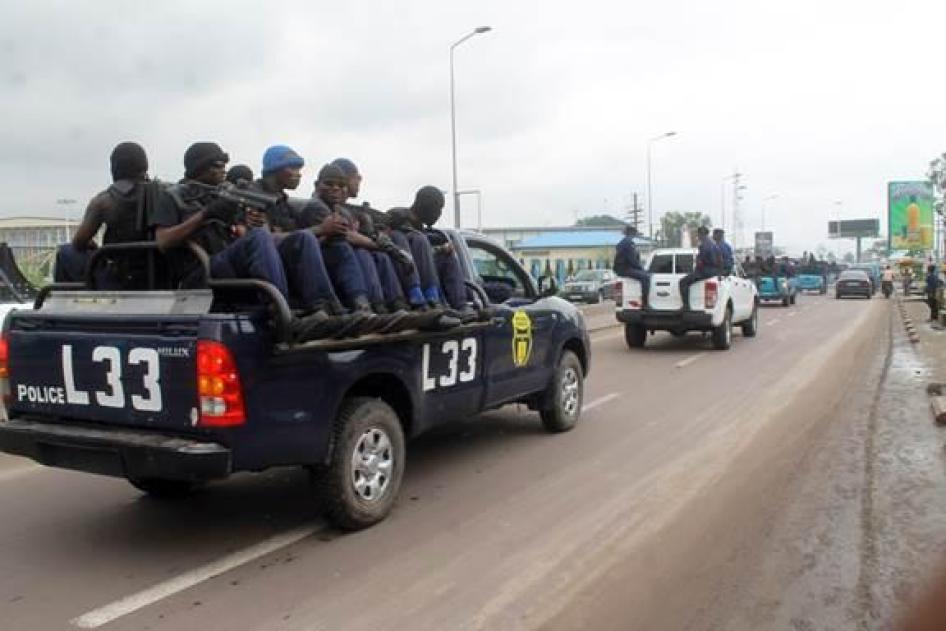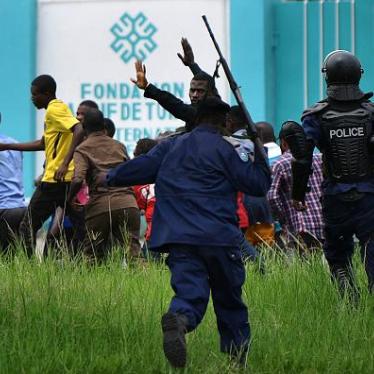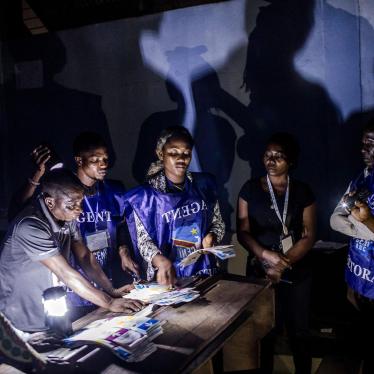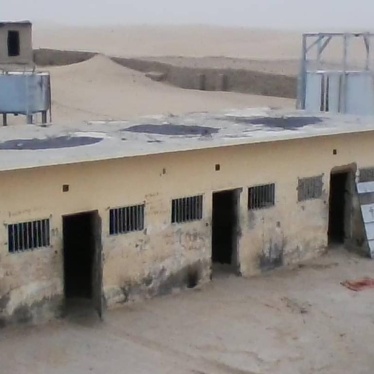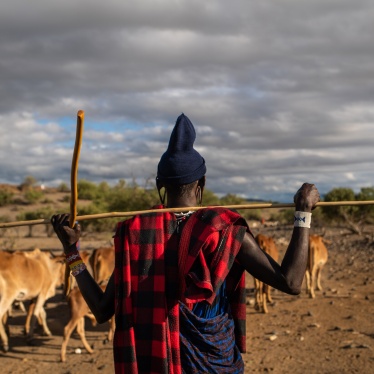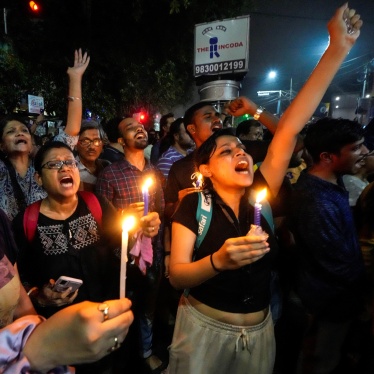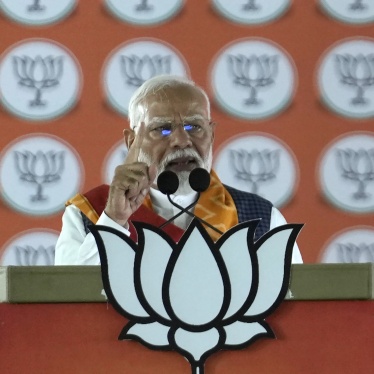(Kinshasa) – Security forces in the Democratic Republic of Congo summarily killed at least 27 young men and boys and forcibly disappeared 7 others during an anti-crime campaign between May and September 2018. The campaign, known among the police as “Operation Likofi IV,” targeted alleged gang members in Congo’s capital, Kinshasa.
Human Rights Watch found that police officers, often wearing civilian clothes, apprehended without warrant suspected gang members, known as kulunas, at night from their homes or other locations. In many cases, the police blindfolded and bound the victims, took them to unidentified locations, and killed them. Often the police dumped the victims’ bodies near their homes early the next morning. Most victims were strangled in an apparent strategy by the authorities to direct attention away from the police.
“Strangling, shooting, and disappearing suspects in custody is never a lawful way to fight urban crime,” said Ida Sawyer, deputy Africa director at Human Rights Watch. “Congo’s new administration should put an end to abusive police campaigns and work to ensure that those responsible for these horrific crimes are investigated and prosecuted.”
Human Rights Watch interviewed nearly 80 witnesses, family members of victims, medical and social workers, activists, government officials, and others in Kinshasa and by phone, between June and December 2018. Those interviewed include four security force members, including a police officer who participated in the operation.
The extrajudicial executions and enforced disappearances Human Rights Watch documented took place between May and September in Kinshasa’s Kalamu, Kisenso, and Limete communes. Three of those killed were boys, ages 16 and 17. A 15-year-old boy is among the disappeared. The victims included known or former kulunas and local residents who, acquaintances said, were not involved in criminal activities.
Credible reports of at least 11 additional cases in Kinshasa need to be verified.
“To prevent him from screaming, they [the police] put a black [wire] around his neck,” said a witness to the killing of a young man on May 12. “They pulled the wire very hard to the point that he started convulsing. He touched his belly and then collapsed.” The victim’s body was dumped in the neighborhood, while two others arrested with him remain missing.
A senior security force officer and several others knowledgeable about the operation told Human Rights Watch that those targeted included kulunas known to mobilize opposition-led demonstrations. Others had refused recruitment efforts by the ruling party or security agencies. Human Rights Watch has previously documented ruling party efforts to recruit, pay, and deploy kulunas to infiltrate and violently disrupt opposition-led protests against former President Joseph Kabila.
Government sources said that one objective of Operation Likofi IV was to spread fear in the capital to deter protests linked to the elections. This took place in the context of broader repression against the political opposition and pro-democracy activists in the country.
Kulunas have been responsible for serious crimes in Kinshasa, including armed robbery and violent assaults. The first Operation Likofi, from November 2013 to February 2014, implicated the police in the summary executions of at least 51 young men and boys and the forced disappearance of 33 others.
The Likofi IV killings began soon after Henri Mova, the vice prime minister and interior and security minister, presented a national plan on April 10 to fight urban criminality, including by eliminating the so-called kuluna phenomenon.
Several weeks later, on the night of May 3 to 4, police dragged four alleged kulunas from their homes and fatally shot them, leading residents to believe that a new “Operation Likofi” had begun.
Security force officials suggested to Human Rights Watch that subsequent victims were strangled rather than shot, since the use of firearms pointed to police responsibility for the killings.
In all the cases Human Rights Watch investigated, witnesses said that the victims were unarmed and posed no imminent risk to life that would have justified the police using lethal force. They said the assailants wore civilian clothes or partial or full police uniforms, and masks and hoods to hide their faces. In some cases, the assailants arrived in police jeeps or described themselves as police officers.
On September 10, the police paraded about 375 alleged kuluna suspects in a police camp in the capital. The Kinshasa police commissioner, Gen. Sylvano Kasongo, told the media: “As long as the kulunas exist, we will not let up.... We’re still on their trail. We’re going to track them down to their last hiding places.” Four days later, police arrested at least seven alleged kulunas in Kalamu commune. The bodies of five of them were found dumped on the side of the road early on the morning of September 16 with signs of strangulation. Two others remain missing.
Four police officers and an informed social worker said the police participating in Operation Likofi IV came from various police units, notably the Anti-Criminal Police of Kinshasa province, commanded by Col. Jean Lazubiene, and the National Intervention Legion (LENI), under Gen. Elvis Palanga. Police accounts link Kinshasa’s police commissioner, General Kasongo, to the Likofi IV operations. As Congo’s interior minister, Mova has responsibility over the police and overall responsibility for the killings and disappearances.
General Kasongo denied to Human Rights Watch the existence of any police operation targeting kulunas. In a phone conversation with Human Rights Watch on December 18, Minister Mova called the allegations “absurd,” adding, “I can’t have a plan to kill people. What would I gain in killing a kuluna?”
On January 24, 2019, Félix Tshisekedi was sworn into office as president of Congo following disputed elections. The new administration should suspend from office any government or security force official credibly implicated in extrajudicial killings or enforced disappearances pending a thorough, fair, and impartial investigation, Human Rights Watch said. The European Union and United States should consider imposing targeted sanctions, including travel bans and asset freezes, against such individuals.
“Kinshasa police executions and disappearances appear to have been part of a broader government strategy to instill fear and deter protests before the elections,” Sawyer said. “Congo’s international and regional partners should press the new Tshisekedi administration to ensure justice for the dozens of victims of this abusive police operation.”
Accounts of Police Abuses During Operation Likofi IV
The names of victims have been replaced by pseudonyms to protect their relatives and witnesses.
The extrajudicial killings during Operation Likofi IV that Human Rights Watch documented followed clear patterns. The police apprehended young men and teenage boys at night, without presenting warrants, in their family homes or other places where they slept or worked, such as hotels, construction sites, warehouses, bars, and shops. Available evidence shows the police typically took the victims to an unidentified location and strangled them or shot them dead. Police summarily executed at least three alleged gang members in the presence of their relatives.
Security forces were often accompanied by an alleged kuluna, sometimes also wearing a mask, whom they used as an informant to show where other suspected kulunas were spending the night. In at least three cases, the informants were also killed. Police sometimes took phones, money, and other belongings they found during the arrests. In the early morning hours following the apprehensions, police dumped the victims’ bodies near the place of their arrest. In two cases, the bodies were dumped on the outskirts of Kinshasa, far from the family home.
Based on accounts from family members and people who found the bodies, including a morgue worker, police officers, and a cameraman, 23 of the victims had clear marks of strangulation while four others had bullet wounds. Some had marks indicating that their arms had been tied behind their back, while at least three had amputated genitals, and others had broken teeth or stab wounds.
The bodies would frequently lie on the street for several hours – generating panic and fear among residents – until uniformed police picked up the bodies and took them to a morgue. Police often intimidated victims’ family members and in some cases, prohibited them from organizing a funeral or traditional mourning gatherings, forcing families to go directly to the cemetery after the body was removed from the morgue.
Some families were unable to recover the bodies from the morgue because of exorbitant fees. Human Rights Watch also documented cases in which the bodies of victims were kept in very poor conditions and decomposed quickly, forcing families to proceed directly to burial. The father of one victim was forced to sign a document at Kalamu police station masking the full circumstances of how his son died.
Human Rights Watch has not been able to identify any efforts by Congolese police to investigate these unlawful killings and enforced disappearances.
Kalamu Commune, Matonge Neighborhood, May 4
On May 4, at about 2 to 3 a.m., a group of armed men in civilian clothes, at least one of them wearing police uniform pants, apprehended and killed a street youth named Mathieu and three other men.
Mathieu’s partner told Human Rights Watch that the masked men abducted Mathieu near the Cabu bridge in Kalamu commune, where she and Mathieu and their 8-year-old son spent the night. Over an hour later, the assailants brought Mathieu back to the place where he had been taken, in a pickup truck without a license plate and with three other people, she said, all with their arms tied behind their backs.
The assailants then shot the first man with two bullets in the back, and then they killed her partner. “Mathieu was shot dead in the presence of our son,” she said. “They untied his arms and told him to ‘make love with a tree trunk.’ As he was pulling his pants down, they shot him four times in the back.” They then killed the other two men elsewhere. About 5 a.m., all four bodies were thrown onto the street near the Cabu bridge.
Kalamu Commune, Matonge Neighborhood, May 12
On May 12, at about 1 a.m., alleged police officers in civilian clothes abducted four men, three of them from a warehouse where they spent the night in the Matonge neighborhood in Kalamu commune. “Men in civilian clothes with masks came into the compound in a white jeep and arrested [three of the young men],” a witness said. “They tied them up from their feet to their neck with wire used to dry clothes, and then they left with them.” One of them was later found strangled and dumped nearby while the other two remain missing. The fourth man was abducted at about the same time in the same neighborhood by armed, masked men in civilian clothes. He remains missing.
Kalamu Commune, Yolo Nord Neighborhood, June 16
On June 16, at about 2 a.m., armed men in civilian clothes apprehended four men, ages 23 to 34, from a bar in the Yolo Nord neighborhood of Kalamu commune, where they had been attending a birthday party. The assailants later called the family of Benjamin, one of the men. Benjamin’s sister said that the assailants passed the phone to Benjamin, who told his family: “They’re asking you for money. I’m still blindfolded, with my arms tied behind my back. I haven’t eaten anything since they took me.” The family did not have further contact with Benjamin or the assailants, and no money was paid.
The next day, Benjamin’s body and that of another young man taken at the bar were found strangled and dumped in the Yolo Nord neighborhood. The two other men were found strangled in the Mingadi neighborhood on the outskirts of Kinshasa. The mother of Christian, another of the victims, said:
It was when the images of two dead bodies were broadcast on TV that we learned about [Christian’s] death. The public morgue officers told us that they had received police orders that we had to bury him there in Mingadi under police supervision.
Kalamu Commune, Yolo Sud Neighborhood, June 17
On June 17 in the Yolo Sud neighborhood of Kalamu commune, two young men and a teenage boy were abducted from their family homes between 3 a.m. and 4 a.m. The bodies of the three were found strangled the next morning between 4 a.m. and 5 a.m.
José, 20, was taken by armed men who came in a police jeep. His grandmother told Human Rights Watch: “When I followed them to get my grandson back, they threatened to shoot me and told me they were taking him to Camp Kokolo [a military base].” José’s grandmother said: “We [later] found his body, killed by strangulation, with his genitals cut off and deep wounds on his neck and chest. How cruel!”
The sister of Fidèle, 20, said:
A neighbor came to inform us at around 5 a.m. [on June 18] that he had seen [Fidèle’s] body dumped on an avenue near our house. When we got there, we found that he had been strangled, with scratches on his face and his genitals cut off.
Armed men in civilian and police clothes wearing masks who said they were police took Stephen, 16, from his family’s home. “The intelligence agents forbade us from even holding a funeral for our son and the mourning ceremony at our home,” Stephen’s father said.
Kisenso Commune, Ngomba Neighborhood, June 21-22
On June 21 and 22, police arrested four men, ages 26 to 30, who all knew each other and lived in the Ngomba neighborhood of Kisenso commune. Police first took two of the men, Christophe and Trésor, at around 9 p.m. on June 21, as they watched a televised football match in a bar. Christophe and Trésor were then used as informants to lead to the two other men, Romain and Gilbert.
Romain’s wife said:
The police arrived at our house around 3 a.m. [on June 22], broke the door down, and presented themselves as “Operation Likofi.” They were accompanied by another local youth who they used as their “scout.” Then they took my husband and left with him.
Romain is still missing, while Gilbert and the two men used as scouts, Christophe and Trésor, were all found strangled to death on the morning of June 22 in the same area.
Police officers arrested a fifth man in Ngomba neighborhood, Nicolas, on the night of June 22 in the same area, as he was allegedly attempting to rob a house. His body was found lying on the street after a few hours, with signs of strangulation, near the place of arrest. Angered residents then burned his body in an act of mob violence.
Limete Commune, Mombele Neighborhood, June 25-26
On June 25 and 26, seven boys and men ages 16 to 23, most of whom knew each other, were taken from Mombele neighborhood in Limete commune. Six were later found dead, strangled, and one is still missing. Toussaint, who was apprehended on June 25, acted as an informant for the police and identified most of those taken until he himself was killed.
About 2 a.m. on June 26, armed men, masked and hooded and accompanied by Toussaint, broke into a compound and arrested a young man, Daniel, whom Toussaint identified. A witness said:
These men searched the compound. They broke the door down and one of them hit [Daniel] in his eye with the butt of his gun. Toussaint then entered the compound and told the others, “This is [Daniel].” The men then tied [Daniel] up on the spot and left.
Daniel’s body was found on the street a few hours later, at about 5 a.m., with signs of strangulation. His mother said:
When family and friends came to comfort us after the discovery of [Daniel’s] body, a group of at least 20 armed police officers came to our house and ordered everyone to leave. They told us that they had received orders from the government that mourning would not be permitted. Later, when we learned how our children’s bodies had decomposed and the enormous sums to be paid to remove the body from the morgue, we decided not to remove [Daniel’s] body [from the morgue]. Let the government that killed him bury him!
In the same neighborhood, also around 2 a.m. on June 26, armed men, some in civilian clothes and others wearing police uniforms, arrived at two compounds in a Toyota vehicle and a police jeep. They broke into the compounds and arrested Papi and Léon, who were also identified by Toussaint, according to witnesses. Papi and Leon’s bodies were found near their homes a couple of hours later with signs of strangulation.
At around 3 a.m., armed men in civilian clothes, hoods and masks, some carrying iron bars, entered the compound of another young man, Roger. Toussaint, who accompanied them, identified Roger, and the armed men left with him, said Roger’s brother who witnessed the incident. Roger remains missing.
Toussaint, the informant, was also killed that night. His mother said:
When my late husband, who died a month after my son’s execution, went to the morgue to recover [Toussaint’s] body, it was already decomposing, smelled bad, and had a bloated stomach. We had no choice; we couldn’t take a corpse home in this condition.
The others executed in Mombele on June 25 and 26 included Adam, 23, taken from a construction site on the night of June 25, and Pascal, 16, apprehended on June 17 in the same area. Adam’s body was later found strangled and thrown on the street. Pascal’s mother found her son’s body, naked and with signs of strangulation, on June 26.
Kalamu Commune, Kauka Neighborhood, September 15
On September 15, between 2 and 4 a.m., armed men in civilian clothes, wearing hoods and masks, and some partially in police uniforms, abducted seven teenagers and men, ages 15 to 28, in the Kauka neighborhood of Kalamu commune. The armed men came in Toyota cars and police jeeps. Five of those taken – Ernest, Bruce, Joe, Georges, and Thomas – were found dead, with signs of strangulation, in their neighborhood the next day. The two others, Sylvain and Richard, remain missing.
Around 2 a.m., about a dozen armed men broke into Bruce’s compound. They were accompanied by a handcuffed and hooded person, also wearing a mask, whom they used as an informant, Bruce’s cousin said.
Bruce was found strangled to death two hours later. His body was left near the family home on a basketball court next to the strangled body of Georges, another young man from the neighborhood.
About 2:45 a.m., armed men in civilian clothes climbed the fence of the family compound of Ernest and Sylvain, two brothers. Their aunt said, “I asked them who they were. They told me that they were police officers and that they had been sent here.” They entered the house while Ernest and Sylvain were sound asleep, woke them up, and took them away. She said they were led to an informant who identified them, adding, “I followed them and saw that they had a blue police jeep and two Toyota cars. They also took phones and money from our home.” About 4 a.m., Ernest’s body was found with signs of strangulation and his genitals cut off near the family home. Sylvain remains missing.
At around 3 a.m. on September 15, men with pistols came in a police jeep and then climbed the wall into the compound where the brothers Joe and Richard lived. The assailants woke everyone up and made them get out of the house. Joe and Richard’s uncle said:
They began to take one person after another out of the compound, bringing them to their vehicle so that a person who was there could identify the wanted person. My two nephews were identified, and then the assailants left with them. The next morning, we found [Joe’s] body. He had been strangled to death. [Richard] is still missing.
At about the same time, armed and hooded men arrived at Thomas’s family residence. They climbed the fence into the compound and arrested Thomas and three of his friends who were sleeping with him in the yard. Thomas’s body was found with signs of strangulation at around 5 a.m., two avenues away.
Accounts from Security Force Members, Social Workers, and Activists
Human Rights Watch interviewed four security force officers, who spoke on condition of anonymity, about Operation Likofi IV.
A police officer from the anti-crime police, who participated in the operation, said that the operation began in May, after police were ordered to map where the kulunas lived. He said that they were instructed to operate at night, without leaving traces of bullets, and that they had to kill by strangulation.
Another police officer, who said he attended a meeting with Gen. Kasongo in August, reported that Kasongo told them that the government no longer wanted to hear about the kulunas, that they had to identify the real kulunas, and that all the kulunas had to “disappear.”
In a phone conversation with Human Rights Watch on December 11, Kasongo denied the existence of any police operation targeting gang members. “Since I’ve been in charge, we haven’t done an Operation Likofi,” he said. “If we arrest kulunas, we send them to justice. The police I command aren’t involved in any operation to kill kulunas. We’re republican police, we need to respect human rights, only God can kill someone.”
A social worker said that before Operation Likofi IV began, police officers informed them that there would be an operation targeting young people: “My sources warned me that Operation Likofi IV had to be carried out in complete discretion, without using firearms [thus the killings by strangulation].”
The social worker surmised that the killings were intended to affect the upcoming elections:
I think that those in power know that the youth are not on their side, at least not the young people in Kinshasa. As the elections approach, they must ensure that the youth do not turn against them. And to do that, you have to create that fear.
A security services officer suggested in September that the objective of the operation was to discourage young people from mobilizing to demonstrate on the margins of the December elections:
They targeted the leaders, who are known and who mobilize other young people. Fear had to be created to prevent them from responding to calls to demonstrate in the run-up to the elections. The neighborhoods have also been well targeted, most of them are neighborhoods where young people often demonstrate against Kabila. Officially, the aim was to fight urban crime, but the real goal was to discourage young people by killing their leaders, those who demonstrate, and to create a psychosis in the capital before the end of the year so people would be afraid to demonstrate.
An activist said that security force sources had told him that kulunas who were not with the government were targeted:
The objective was to target leaders of gangs in all hotspots; leaders who could become violent and who are being recruited by politicians. They [the security forces] have mapped out the kulunas in all the hotspots. And it is the kulunas who are not with the government that have been targeted. For them [security forces], it was necessary to neutralize any insurrectional movement in the run-up to the elections. They chose neighborhoods like Yolo, Mombele, and others [neighborhoods known to be with the opposition].
These police officers operated in civilian clothes to avoid being detected. They left the bodies not far from where they were abducted, near their homes, to deter and create fear, especially among young gang members who are not with the government. Who dares to create disorder when they see how their friends have been killed? Strangled? They will just fear that the same fate will await them.
“Operation Likofi”
Likofi means “iron fist” or “punch” in Lingala, one of Congo’s four national languages. During the first Operation Likofi, the Congolese police summarily executed at least 51 young men and boys and forcibly disappeared 31 others between November 2013 and February 2014. The operation targeted alleged gang members in Kinshasa.
When the government admitted that 421 unidentified bodies had been buried in the middle of the night in a mass grave in Maluku, on the outskirts of Kinshasa, families of those killed or forcibly disappeared during Operation Likofi and during the January 2015 protests against proposed changes to Congo’s electoral law feared that their loved ones may have been among those buried there. There has still been no clarity on who was buried in Maluku – or what has happened to the victims forcibly disappeared.
Two days after the United Nations published a report in October 2014 on Operation Likofi, the Congolese government expelled then-UN human rights director in Congo, Scott Campbell. A month later, Human Rights Watch published a report detailing its findings on the operation.
Grave human rights violations by the police during Operation Likofi provoked widespread condemnation and led the United Kingdom and United States to suspend their police reform programs in Kinshasa. In June 2016, the US imposed sanctions against Gen. Célestin Kanyama, the then-police commander in Kinshasa, and the European Union then sanctioned him in December 2016.
In May 2016, the Congolese government released its evaluation report on Operation Likofi, acknowledging that there had been several shortcomings in the operation partly due to the lack of briefings and dissemination of orders at all levels. The Inspectorate General acknowledged that it had dealt with 18 complaints, 2 about executed people and 16 others about people who were missing.
At least 14 police officers were later arrested and convicted without the ability to appeal, while three others were convicted in absentia. However, no commanding officers have been investigated or brought to justice in relation to Operation Likofi.
Operation Likofi was later expanded to include “Likofi II,” which targeted soldiers and police responsible for crimes committed in Kinshasa. On October 16, 2014, then-interior minister, Evariste Boshab announced “Likofi III” to fight against the resurgence of gangs. On May 7, 2016, Boshab announced the start of “Likofi Plus,” extending the fight against urban criminality to all of Congo’s provinces. These operations were then dormant until Mova launched the new, more covert “plan to fight against urban criminality” – Likofi IV – in April 2018.
